
Expand Your Palette: Waterwise Plants for your Landscape
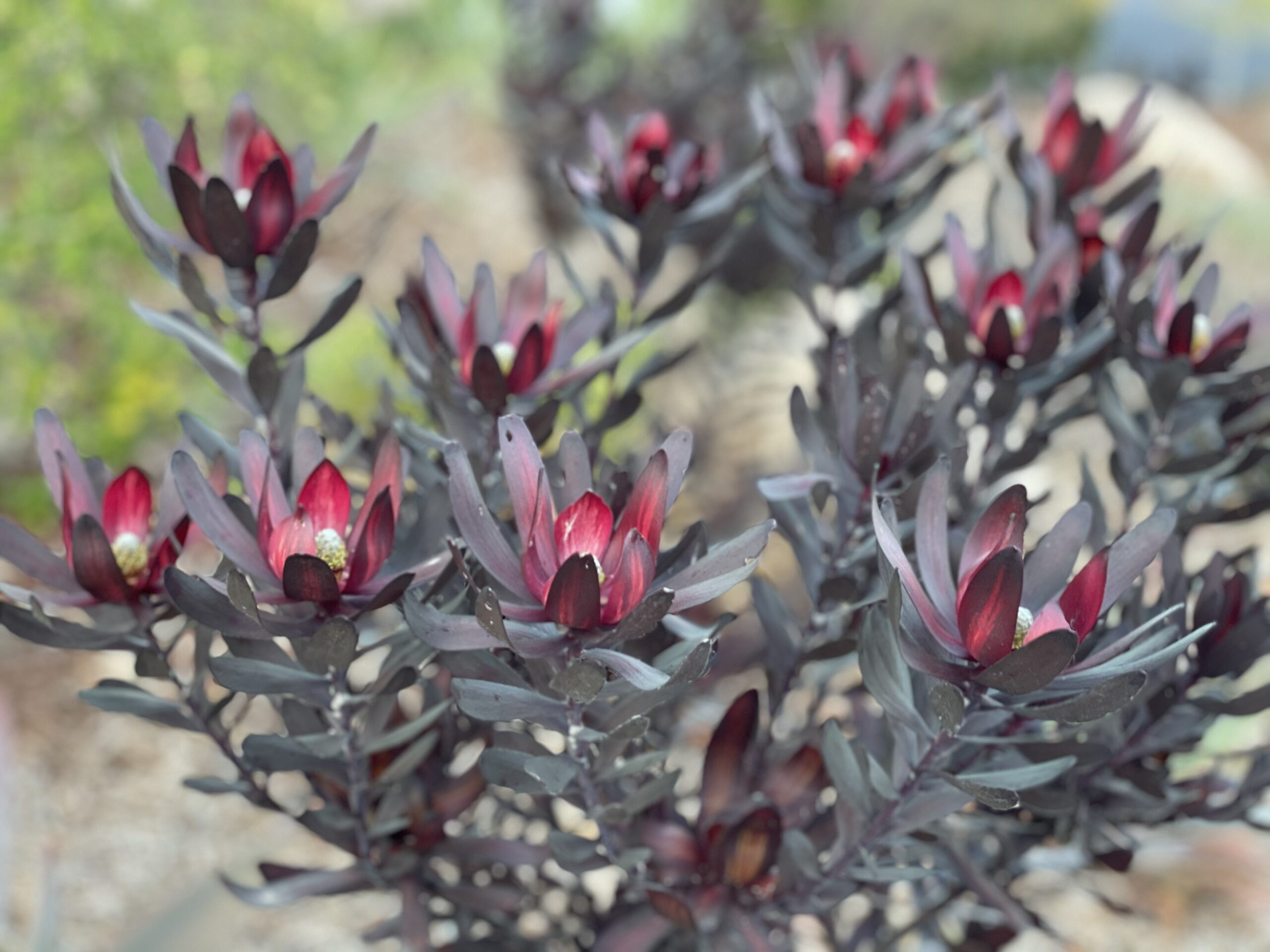
Contributor
There’s nothing more thrilling to plant lovers than discovering new plants to test in the garden. Here in the southernmost corner of California, we have the continent’s greatest biodiversity of native plants and a climate that allows us to grow an enormous variety of climate-appropriate, non-native plants, too. Our garden potential is limitless, as long as we respect our soil types and water limitations.
Last October, Pacific Horticulture held its Celebration of Local Biodiversity at San Diego Botanic Garden in my hometown of Encinitas, California. I was invited to speak about non-native, waterwise plants that are perfect for our gardens but aren’t so well known. The plants were selected and supplied by my friend Gregg Opgenorth, head grower and production manager at Grubb & Nadler wholesale nursery, east of the botanic garden by about 35 miles.
I was thrilled by the plants Gregg selected. If you live in coastal California or in any other arid, mild winter region, these plants should work for you as well. Here’s what I presented:
Pearl acacia (Acacia podalyriifolia) is a smaller evergreen tree, 18–20 feet tall by 18 feet wide, with a rounded canopy of pale silver-blue leaves that are fuzzy to the touch—the fuzz is a typical water-conserving adaptation to protect leaves from harsh sun and to slow water loss from the leaf surface. In January, pearl acacia erupts in bright yellow pom-pom flowers, each no larger than a grape. The yellow/soft blue color contrast is stunning. In bloom, the tree hums from all the bees that visit the flowers. This sun lover is a good choice for smaller garden spaces where temperatures rarely dip below 20°F at night. Water sparingly.
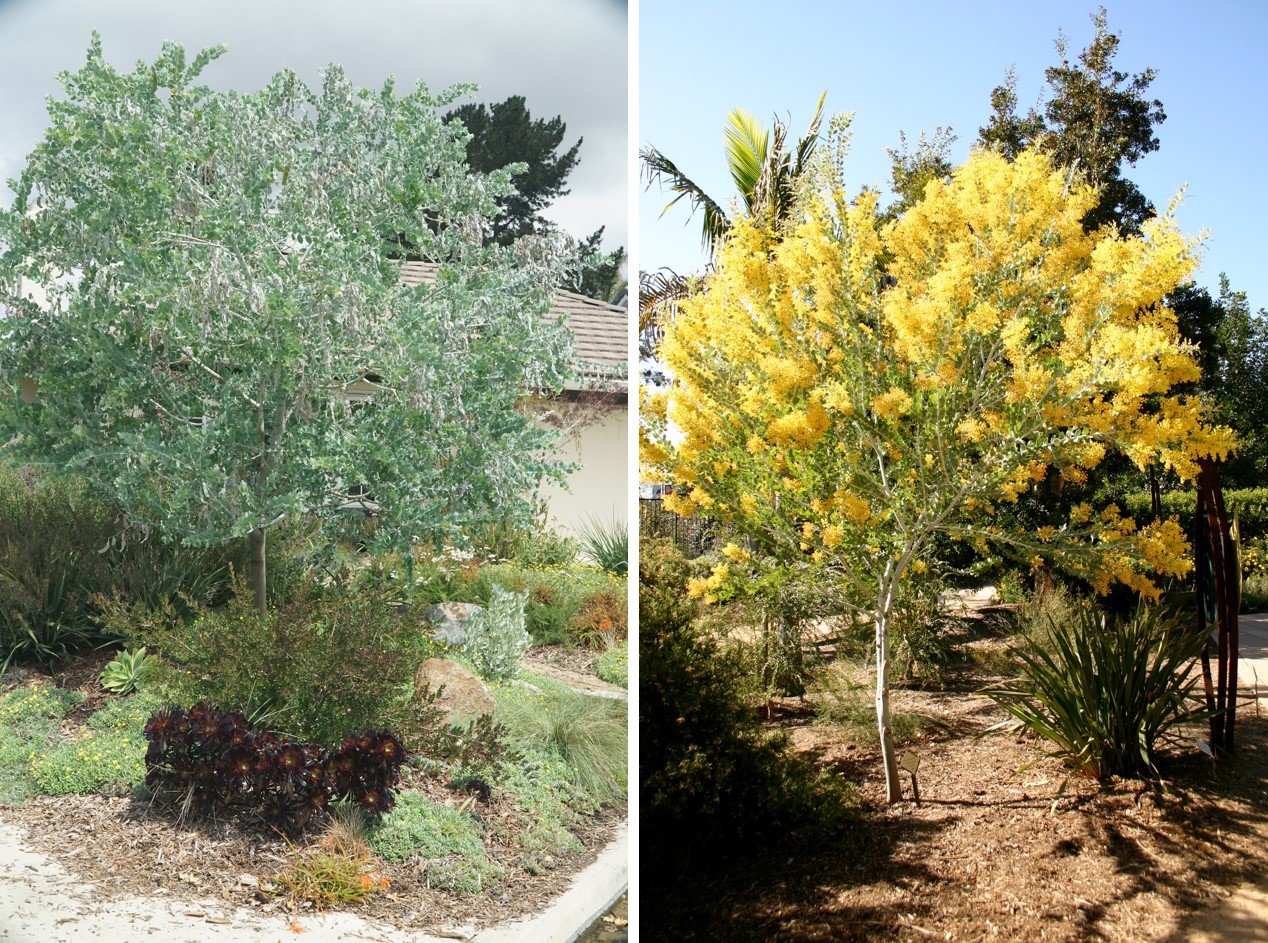
If you love the giant century plant (Agave americana) but worry about root runners, plant majestic agave (Agave franzosinii) instead. A. franzosinii grows 6–8 feet tall by 8–10 feet wide. Its tall, succulent blades are a ghostly blue, not too different from A. americana. But while A. americana eventually forms colonies, A. franzosinii is most often a single rosette. The renowned Lotusland in Montecito, California, features A. franzosinii in their Blue Garden. Grow A. franzosinii in full sun to light shade, where temperatures stay above 15°F.
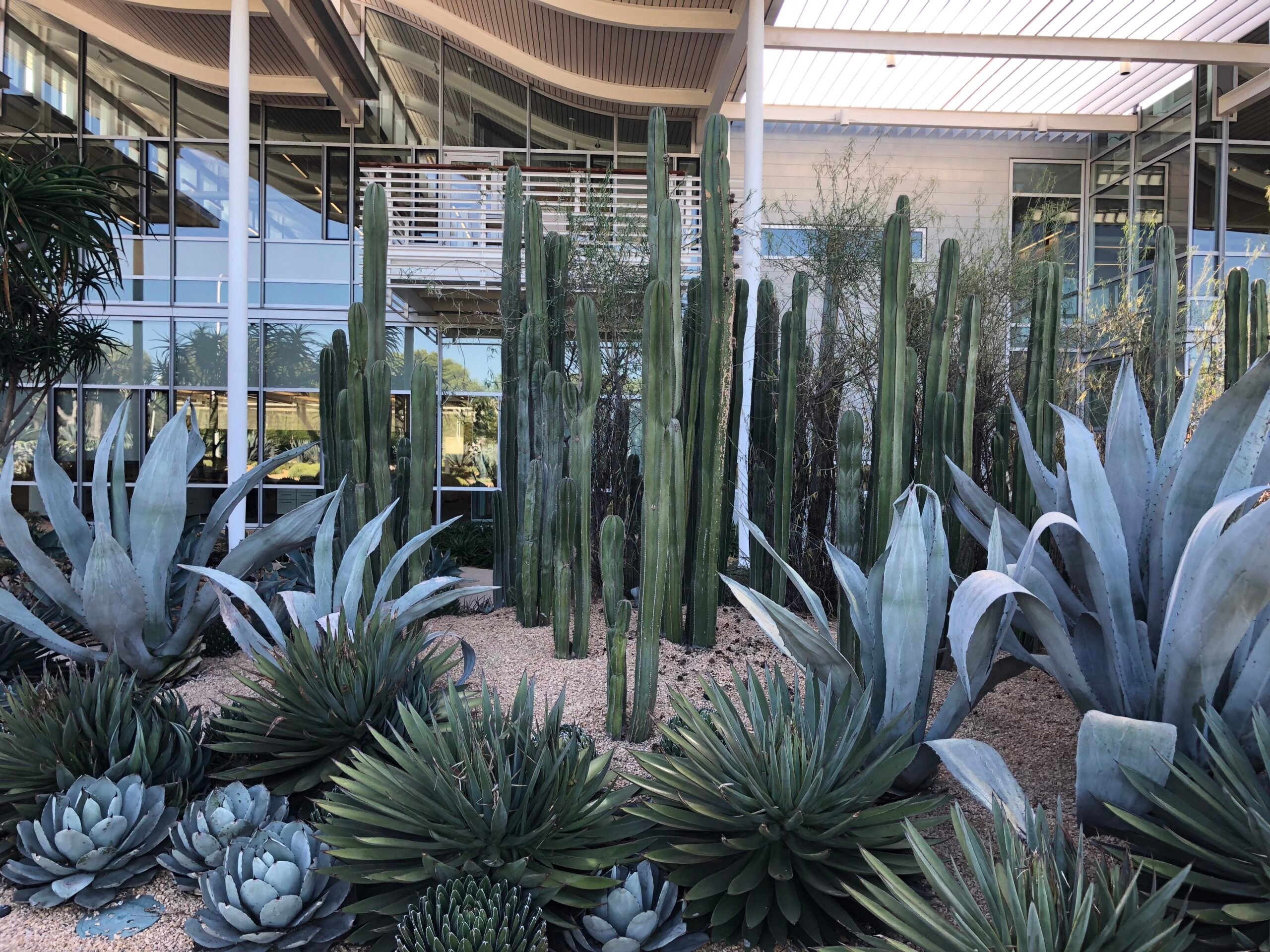
(note: the International Plant Names Index lists this plant as A. americana var. franzosinii and as Agave x – In horticulture, I most often see it listed as A. franzosinii. You can decide which name to use)
Coast banksia (Banksia integrifolia) is a large shrub/small tree, 20 feet tall or taller. Golden-yellow, cone-shaped flower clusters form along the branches (rather than at branch tips) from fall through spring. The “cones” are enormous, up to 10 inches long. Once they drop their fringy flower parts, the plants are left with equally exotic woody seed pods. Bees love the flowers, as do butterflies and hummingbirds. This eastern Australia native is one of the easier-to-grow banksia. It is not picky about soil, takes full sun or part shade, and tolerates winter temperatures down to 15°F.
While thirsty queen and king palms dominate the landscapes of Southern California, I prefer the drier-growing, blue- and silver-frond palms. Of these, my favorite is the blue hesper palm (Brahea armata). This Baja native has a stout trunk and grows slowly to 25 feet tall or taller. In summer, these palms form spectacular, 15-foot-long, arching “wands” covered in cream-colored flowers. Their size, color, and texture make these palms excellent dry garden trees and even good street trees. Blue hesper palms thrive in full sun, need very little irrigation, and tolerate winter temperatures down to 15°F. Pollinators include ants, bees, beetles, and flies (Plant File 2019).
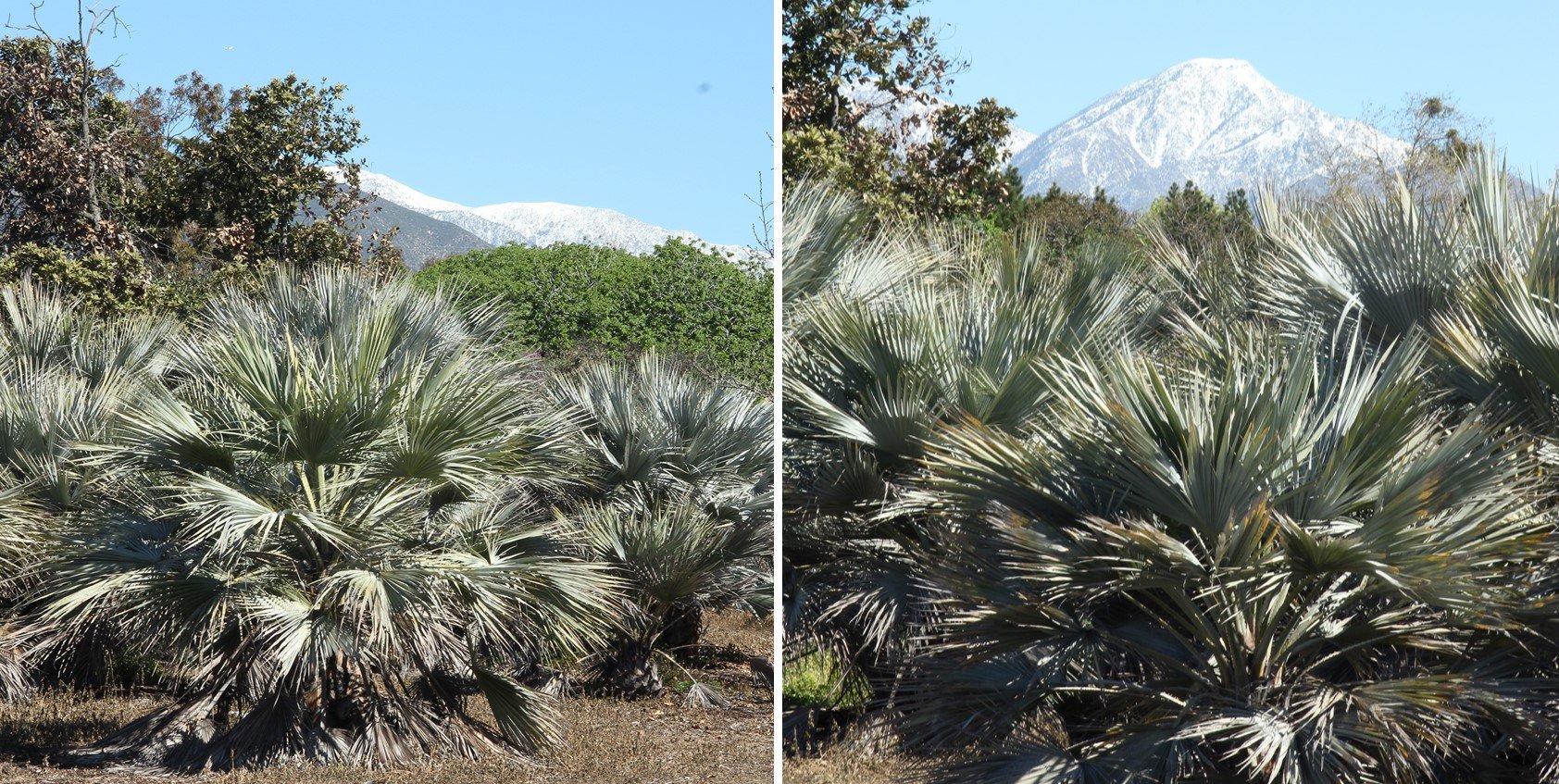
Sotols (Dasylirion spp.) are definitely in the “should be planted more” category. These succulent-like plants are all about shape, form, and texture. Four species of sotols are typically sold in nurseries, including desert spoon (Dasylirion wheeleri) which comes from rocky, arid regions of the Southwest and northern Mexico. This smaller sotol develops a four- to six-foot tall trunk topped in a geometric arrangement of long, narrow, upright blue-green blades with serrated edges. All the blades emerge from the center, which creates fabulous geometry in addition to great color. On occasion, a tall, pale yellow spear emerges from the center of the foliage. This flower stalk eventually reaches 10–15 feet tall, covered in tiny pale brown flowers that look like fuzz. The flowers attract bees, butterflies, and other insects. Desert spoon plants are dioecious, which means that a plant makes either male or female flowers, not both. Unlike agave, the plants don’t die after they bloom.
I often use desert spoon to create contrast in the garden. I combine it with plants that have fine-textured green or gray leaves, like Texas ranger (Leucophyllum), as well as with succulent plants that have fleshy, rounded leaves like pig’s ear (Cotyledon orbiculate).
Moroccan mound (Euphorbia resinifera) is a low, chunky, mounding succulent from the Atlas Mountains. It caught my attention on a recent visit to the stunning landscape that fronts the civic center in Newport Beach, California. There, Moroccan mound is mass planted to create a highly textured ground plane beneath tall dragon trees (Dracaena draco), tree aloe (Aloidendron barberae), and upright majestic agave (Agave franzosinii). Tough-as-nails Moroccan mound grows barely two feet tall but reaches about four feet wide. Tiny yellow flowers appear in winter and spring, but are secondary to the shape and texture of this plant. One caution—like many other spurges (Euphorbia spp.), this one has very irritating sap.
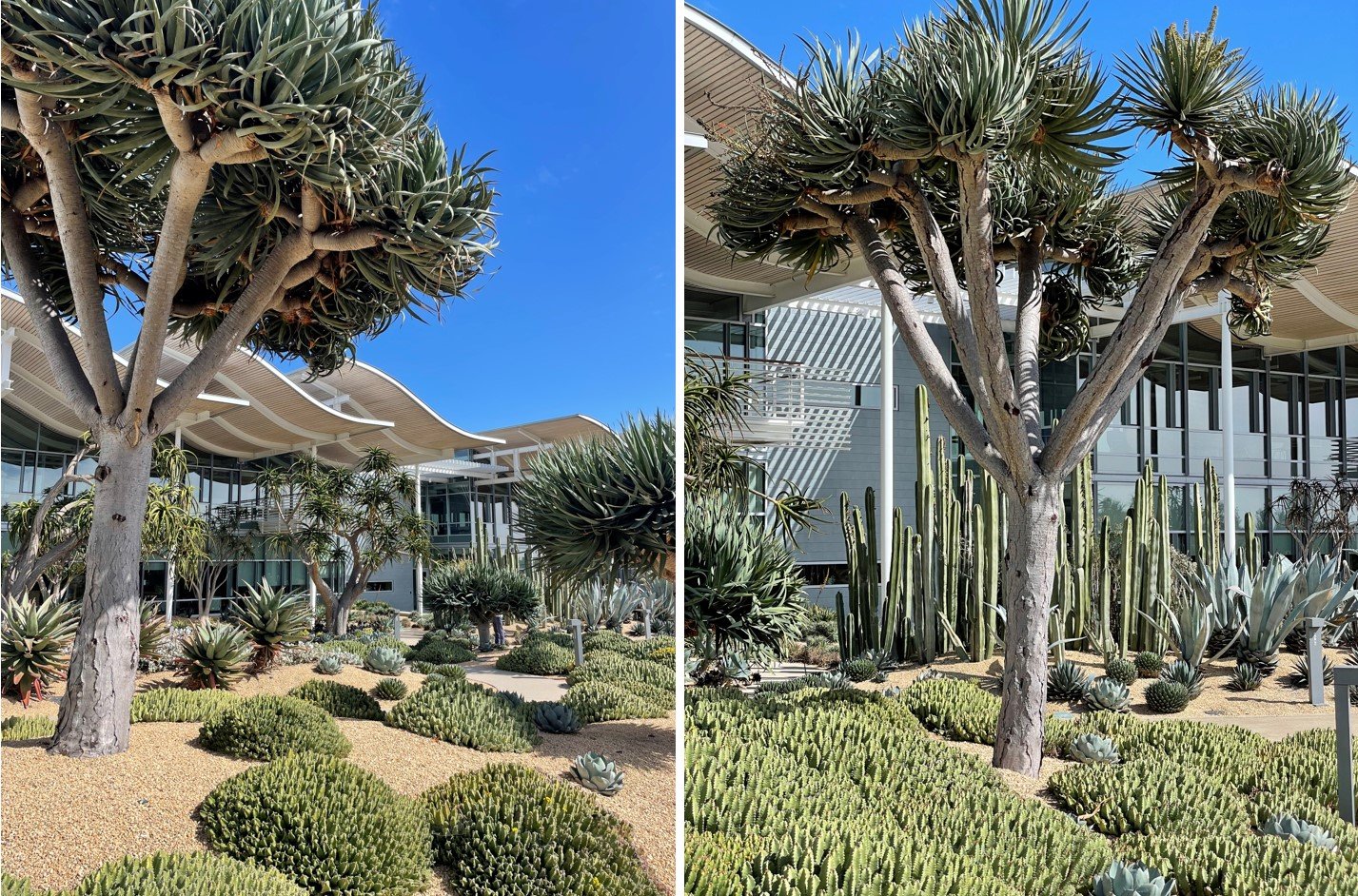
From the Canary Islands comes Euphorbia lambii definitely a Seussian plant. This almost tree-sized succulent features a gray corky trunk and multiple upright branches that look like a cartoon version of a candelabra. Every branch is topped in a tuft of flat, blue-green leaves, each about six inches long. Springtime is flowering time but what look like chartreuse-yellow flowers are actually the plant’s bracts. The true flowers are tiny green structures in the center of the bracts. This is another spurge with irritating sap so wear protective clothing when you prune or clean up. If you get sap on your skin, wash immediately with a product designed to treat poison oak or poison ivy. Plant in full sun or shade, and well-draining soil. Winter minimum is 25°F.
‘Kay Williams’ grevillea (Grevillea ‘Kay Williams’) is one of the taller shrub grevilleas, fast growing to 10 feet tall by 12 feet wide. This grevillea has gray-green leaves and cone-shaped flowers that are orange, pink, and cream. The flowers are bee and hummingbird magnets. Mass planted, ‘Kay Williams’ makes a great natural hedge (don’t prune it) or screen. Mulch well with a wood-based mulch. Like for other plants in the protea family (Proteaceae), do not fertilize with a phosphorus-containing fertilizer. If leaves turn pale green or yellow, apply chelated iron and powdered sulfur in the cool months of the year. Resist watering in summer, when the soil is warm. The plants don’t “expect” water then and wet, warm soil encourages deadly root rot.
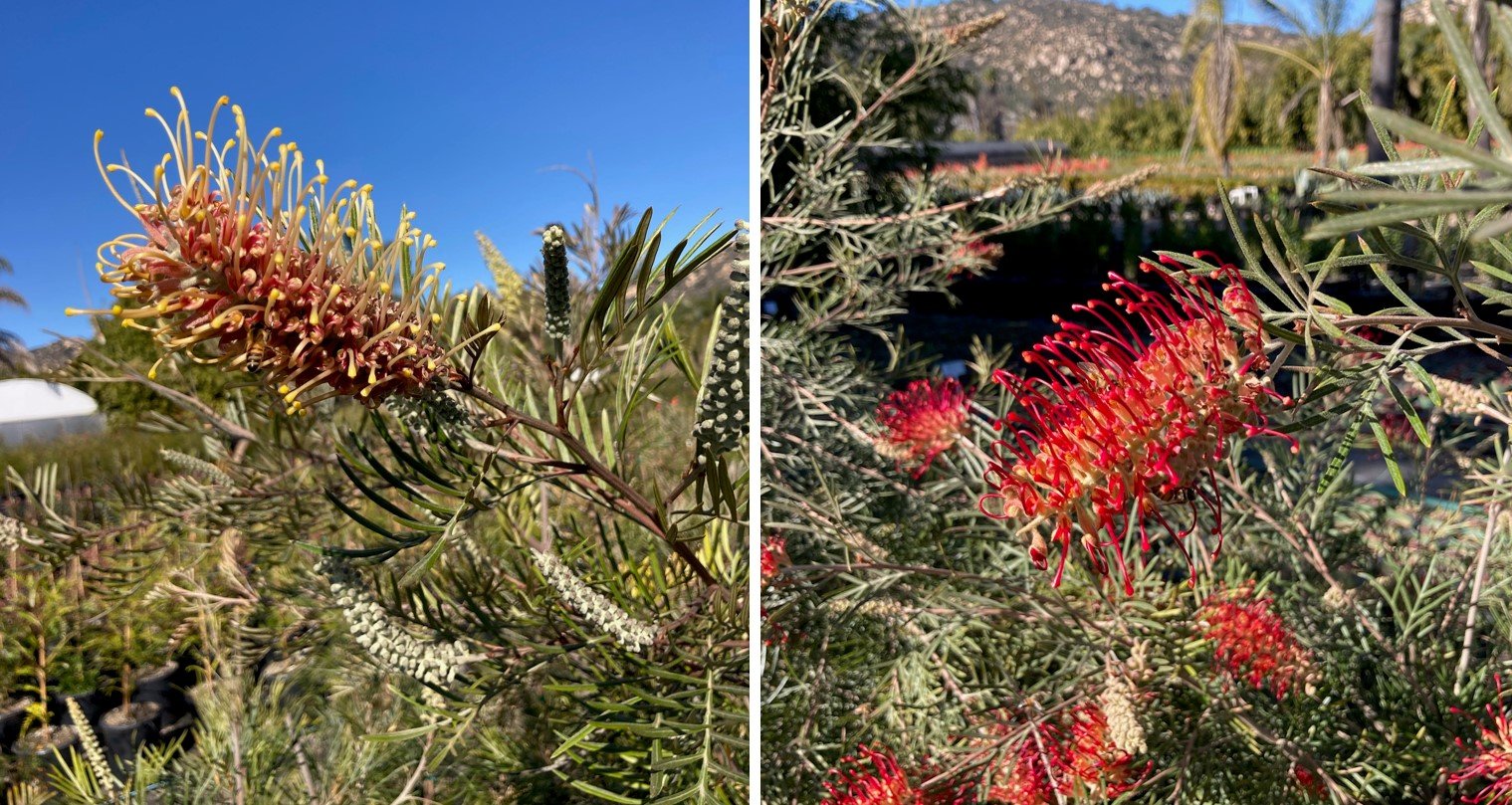
Right: ‘Spirit of Anzac’ grevillea (Grevillea ‘Spirit of Anzac’) Credit: Gregg Opgenorth
‘Spirit of Anzac’ grevillea (Grevillea ‘Spirit of Anzac’) is a recent introduction to the gardening world. The name commemorates a bloody WWI battle on the Gallipoli Peninsula in Turkey, where the Australian and New Zealand armies took quite a beating. The plant has fine, silvery green foliage and winter time flower clusters are bright red. Like ‘Kay Williams’, this 10-foot-tall, 6-to-8-foot-wide grevillea makes a good screen or hedge. It is also a wonderful specimen plant placed in the center or rear of a garden bed. Hummingbirds and bees are frequent visitors. See mulch, fertilizer, and water recommendations for ‘Kay Williams’ grevillea. Tolerates winter temps down to 20°F.

Grass-leaf hakea (Hakea francisiana) is another protea family plant that grows as a large shrub or small tree, up to 16 feet tall by 12 feet wide. Grass-leaf hakea branches are densely covered in blue-green leaves that grow long, narrow, and upright. In winter and spring, that blue-green makes a wonderful background for large, surprisingly pink, cone-like flower clusters. I am always fascinated by how similar hakea, grevillea, and banksia flowers look. They aren’t the same, but like siblings, there is a clear resemblance. Plant in full sun. Grow this sun-lover as a screen, hedge, or focal point. See mulch, fertilizer and water recommendations for ‘Kay Williams’ grevillea.
‘Ebony’ conebush (Leucadendron ‘Ebony’) is a mainstay of my garden and the gardens I design. Like most other conebushes, this one is grown for its colorful foliage, drought tolerance, and amazing leaf texture. Ebony’s deep burgundy leaves are not common in the plant world, yet they are an essential counterbalance to the colors in any garden plan. Most sources describe this as a “dwarf” conebush that grows just three feet tall and wide. However, in the years I’ve been planting it, older plants are now reaching five feet tall by four feet wide. Cut the branches for floral arrangements, and the plant will form multiple new branches at the cut point. Plant with gray-, blue-gray-, and silver-leaved plants like majestic agave (Agave franzosinii) sotols, (Dasylirion spp.), and Big Bend yucca (Yucca rostrata), or emphasize its architecture by planting it with ruby necklace (Othonna capensis ‘Ruby Necklace’) or rainbow bush (Portulacaria afra ‘Variegata’). See mulch, fertilizer, and water recommendations for ‘Kay Williams’ grevillea.
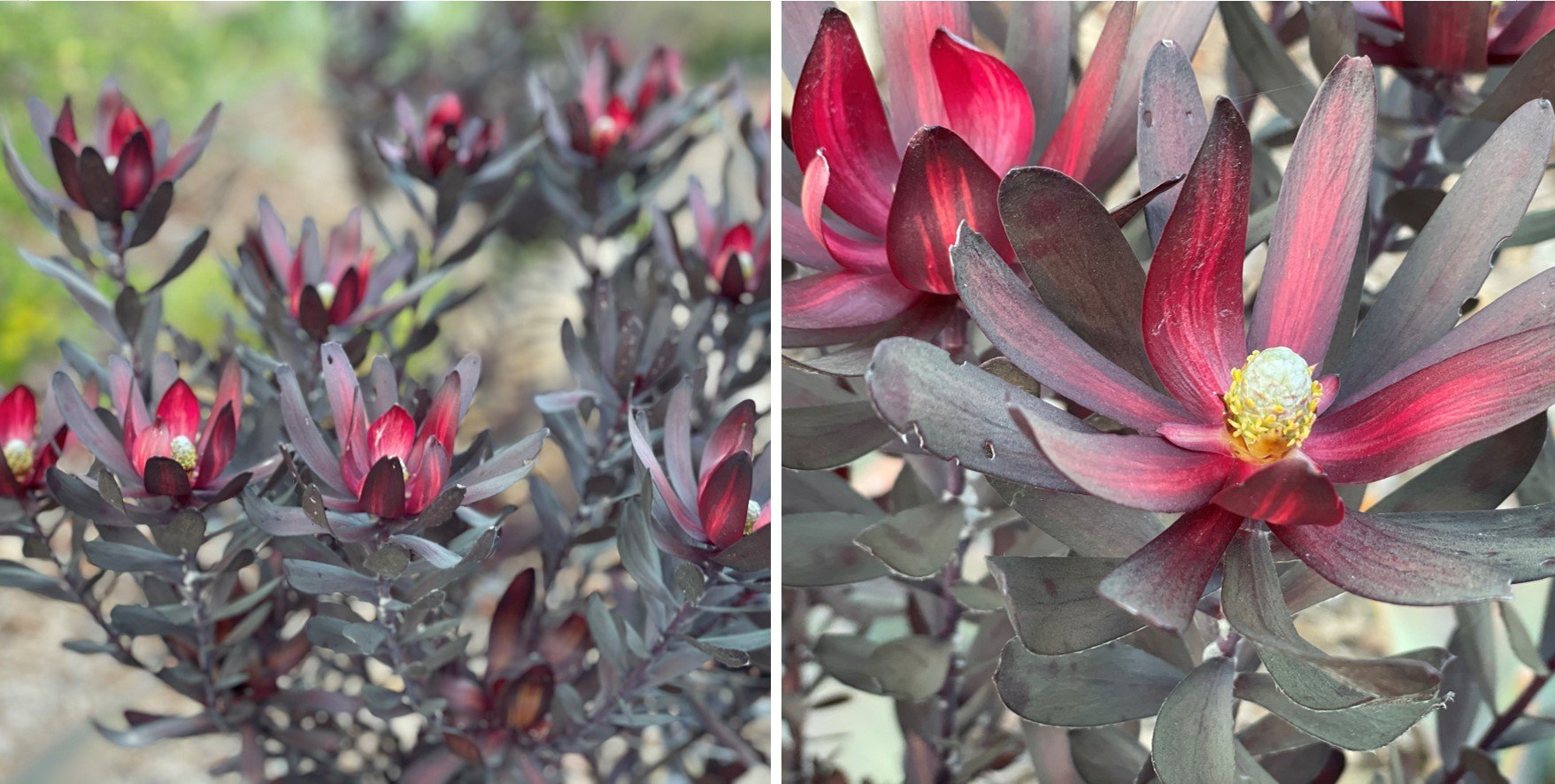
‘California Sunshine’ pincushion (Leucospermum ‘California Sunshine’) is one of many newer pincushions on the market. These gorgeous plants are not for beginners. Pincushions are South African natives in the protea family. Most do best in acidic soils, so our Southern California alkaline soils make it a challenge to match pincushion to soil. It can be done, but there’s some trial and error involved. That said, pincushions are grown for cut flowers on the sunny hillsides of San Diego County, where there’s lots of heat, good water drainage, and excellent air circulation—conditions to emulate in home gardens. ‘California Sunshine’ pincushion grows as a rounded evergreen shrub, 4–5 feet tall and wide. The pincushion flower clusters are softball sized, and soft orange/yellow (compare the flower structure to hakea, banksia, and grevillea). See mulch, fertilizer and water recommendations for ‘Kay Williams’ grevillea.
Ruby necklace (Othonna capensis ‘Ruby Necklace’), syn. Sedum capensis ‘Ruby Necklace’) is the purple version of the diminutive but tough ‘Little Pickles’ creeping succulent. Like the green version, ruby necklace has swollen succulent blades, only an inch or so long each. The blades line long, strand-like stems that, when planted in the ground, form mounds no more than a few inches tall but spreading several feet out. This is a great plant to use as a groundcover or cascading over a wall or the side of a pot. Plant to contrast with a gray- or silver-leaved plant such as desert spoon or majestic agave. Grow in full sun for the most intense purple color. Water only sparingly. Watch for tiny yellow flowers in the cool months of the year. Tolerates temperature down to 10 degrees F.
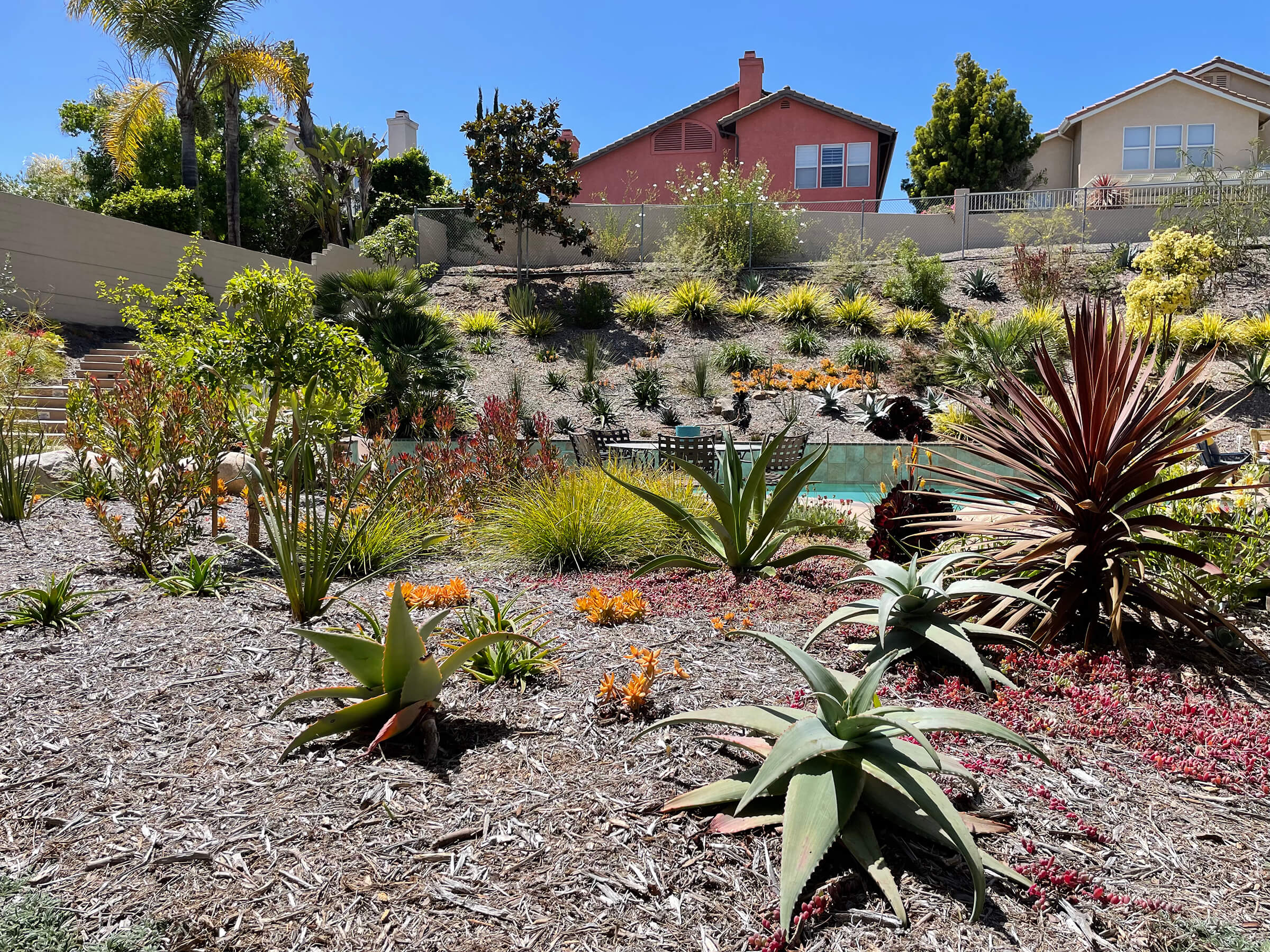
Rainbow bush (Portulacaria afra ‘Variegata’) is a plant that caught my attention recently after years of just passing it by. The common name for this succulent is refers to its small, round, and variegated succulent leaves. The green-and-cream-colored variegation is a beautiful contrast against the plant’s mahogany-colored succulent stems. Pop a leaf or two in your mouth and you’ll be pleasantly surprised by the tart flavor, a favorite of wild and domestic animals in South Africa. Left to reach its natural size, rainbow bush grows up to 8–12 feet tall by 4–6 feet wide. The unusual color combination along with the texture of the leaves and stems makes for a striking combination in the garden. Plant rainbow bush as a screen, up against a wall (paint the wall cobalt blue for maximum color intensity), or contrast grass-like and vase-shaped plants. This fast grower tolerates both full sun and part shade. Water little if at all, but do protect the plant with frost cloth if temperatures go below freezing.
Barberton groundsel (Senecio barbertonicus) is a true shrubby succulent with bright green, upright, succulent branches covered in narrow succulent leaves of the same color. In fall and winter, those branches are tipped in golden-yellow, aster-like flowers.
This plant is often sold in a four-inch pot so few people realize how quickly it grows reaches its mature size of five feet tall and wide. The branches, however, are quite brittle, so site this groundsel away from walkways and paths where passersby could bump it and unintentionally break off a branch. This South African native requires little if any irrigation, no fertilizer, full sun, and a non-wood-based (“inorganic”) mulch. Use frost cloth to protect Barberton groundsel when nighttime temperatures dip below freezing.
Big Bend yucca (Yucca rostrata ‘Sapphire Skies’) deserves much more attention than it gets. Its upright structure is a punctuation point in a dry garden while its powder blue leaf color is absolutely stunning. I can imagine confusing Big Bend yucca for a sotol (Dasylirion), as the shapes of these two genera in the asparagus family are similar. Both have long, narrow blades emanating from a center point, forming almost a ball or pom-pom of leaves atop a stout, gray trunk. If you allow the dried, old leaves to remain, Big Bend yucca looks almost furry as it ages. This slow-growing succulent eventually tops out at 15 feet tall and eight feet wide. As the plants age, they flower in spring, forming stubby, stiff, impressive flower stalks covered in creamy white, golf-ball-sized flowers. This northern Mexico native is a fantastic plant to feature as a specimen—in a container or in the ground—ideally in full sun and well-draining, alkaline soils. Tolerates winter temperatures down to 0°F.
Resources
Plant File. 2019. Brahea armata.
This content was made possible in part by The Saratoga Horticultural Research Endowment (SHRE).
Share:
Social Media
Garden Futurist Podcast
Most Popular
Videos
Topics
Related Posts
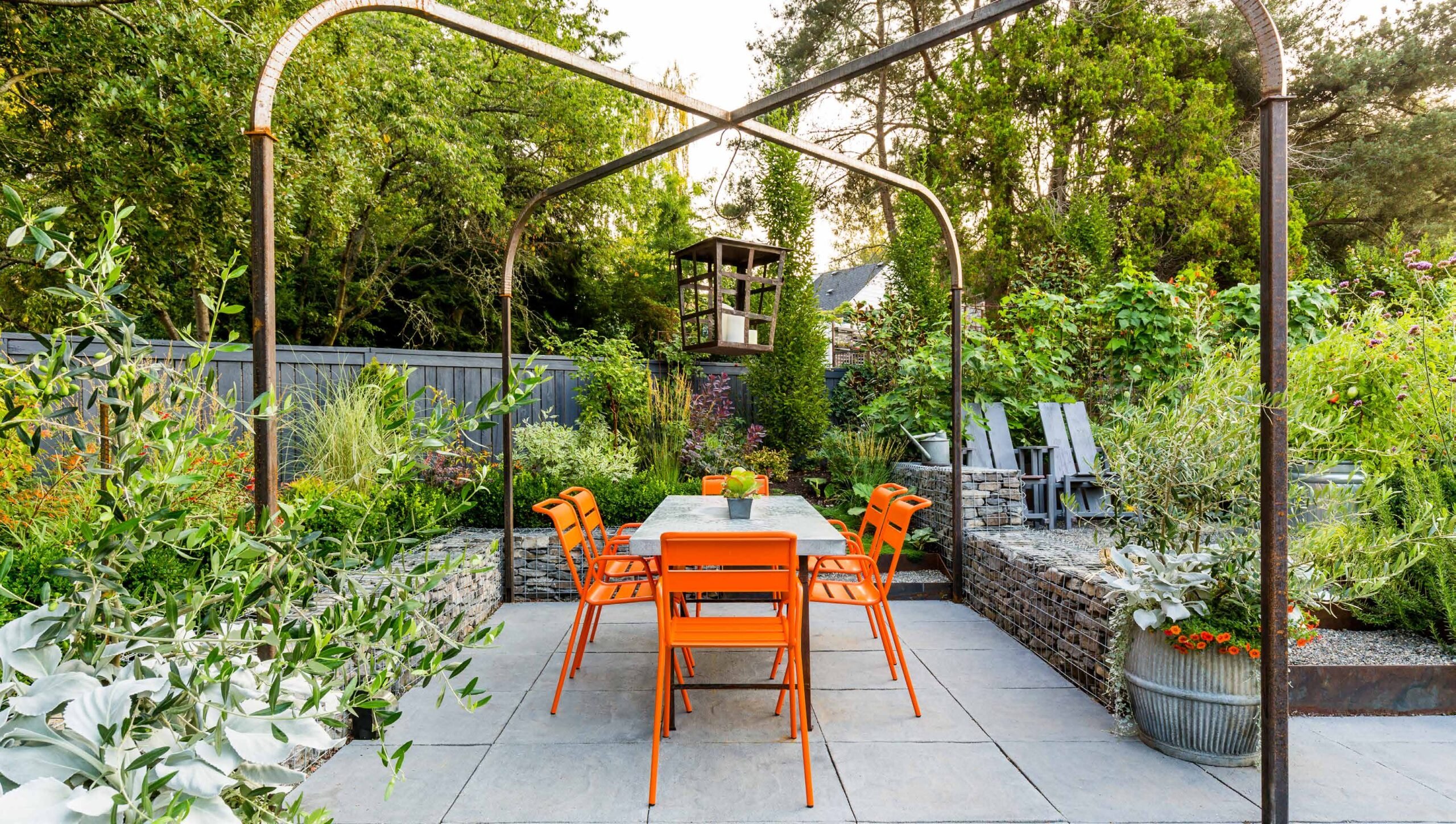
Design Futurist Award Announced: Committee Shares Vision
March 8, 2023 At Pacific Horticulture, we believe that beauty can be defined not only by gorgeous plants and design, but also by how gardens

What Climate is This? Part Two – A Garden Futurist Special
Winter 2022 Listen to the Part 2 Podcast here. If you live in the Pacific region, you know that seasons in your garden look different

Portland Parks’ “Nature Patches”
Winter 2022 Nature is so beautiful when left to its own devices, yet crisply manicured lawns remain a status symbol. This is true in Portland,
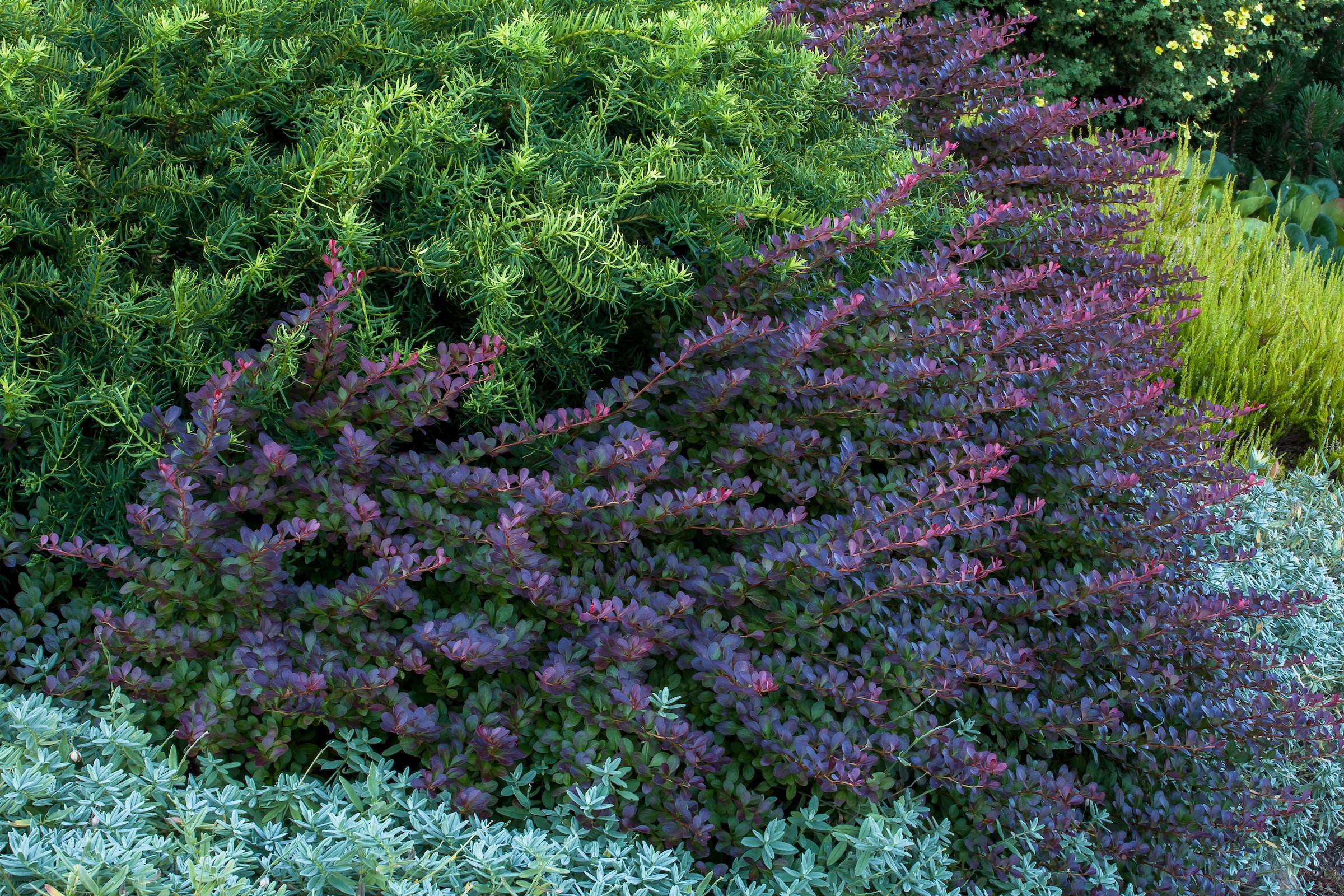
Readily Available Low-Water Plants for a Warming Climate
Fall 2022 Al Shay is the manager of the Oak Creek Center for Urban Horticulture on the campus of Oregon State University (OSU) in Corvallis.

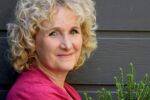







Responses